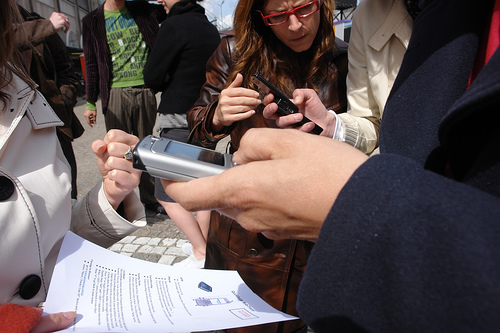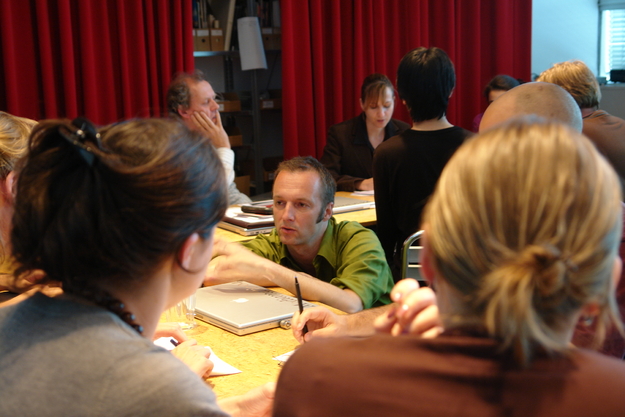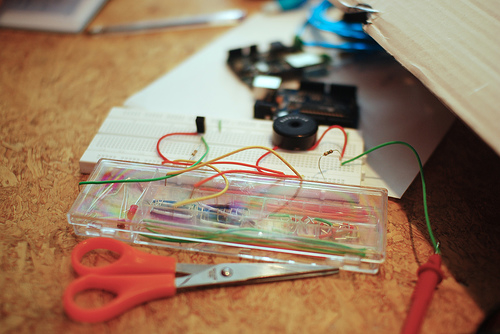Day 1
The day started early Monday morning with an introduction to the workshop by Klaas Kuitenbrouwer explaining the opportunities and goals for the following days. The participants and lecturers introduced themselves showing an impressive array of backgrounds and interests.
Timo Arnall's talk Designing between things, places and people. explored the range of work that is covered by the Touch project, a research project on the social use of RFID (or NFC as the Nokia variant of RFID is called) and on the use of RFID in public space.
One of the main area's of opportunity for the Touch projects are the way in which they reduce our reliance on screen interfaces in favour of more embodied and physical interactions. Location is a primary context for Touch projects. Timo managed here to get people off fantasies on GPS projects almost right away by sharing his frustrating GPS experiences, summed up in the phrase: "It doesn't degrade gracefully."
Ava Fatah Gen. Schieck then investigated some other aspects of the digital layer in urban environments. She analysed the digital space that surrounds individuals, afforded by their bluetooth bubbles. Her Cityware research project looks at the flow of digital data through the physical world by monitoring the use of Bluetooth in the streets.
Giles Lane introduced the group to his work with Proboscis, a group of designers and artists that investigates the ways in which technology can be applied to make deeper interactions between people and with the space around them. He emphasized the importance of really looking at your users, and involving them in an iterative design process, instead of referring to a general and somewhat myhtical user.
Recent trends and design practices in physical world/digital world hybridization were investigated by Nicolas Nova. He emphasized that the hybridized world enables us to have new interaction partners such as animals, objects and locations.
Ava took the stage again to give a consise and very handy overview of uses of and issues around public screens. Following an introduction to RFID technology the group discussed what ideas were percolating for projects to be built during the workshop. The projects collected around the themes tangible interfaces, building community, eavesdropping and public spaces.
Day 2
The workshop considered the options for mobile computing lead by Timo. He introduced us to different kinds of physical hyperlinks to allow the user to interact with physical places and things to get digital information. Giles talked about his Urban Tapestries project and emphasized using familiar technologies when working with communities (boiling down to Proboscis' latest technoly strategy of 'scavenging').
With these points of inspiration in mind the participants split into small groups to discuss their coalescing project ideas. They were catching up with their own plans, and started to lay out their lines of work.
After lunch Nicolas went into the different flavours of locative technologies and showed some engaging locative projects, most notably Familiar Strangers that kept popping up in different lecturers contributions - clearly a key project in terms of locative media.
Also GPS returned somewhat to favour, by featuring in some fascinating contexts.
Sascha Pohflepp followed up this theme with a very entertaining rundown of the mapping tools and related mashups that take advantage of location information (also often provided through GPS) to give users the opportunity to create their own meaningful maps, like the guy that maps all public power outlets in Lower Manhattan.
Picture by Timo Arnall
Day 3
The third day started with a description from Giles of the tangible tools he worked on that facilitate communication and story telling among people, called “Shareables.”
Timo followed with a selection of examples of mobile social software. These programs ranged from creating a micro presence on the web and by phone, to knowing if you have been near strangers before.
Nicolas observed that mobile technologies always seem to be only a few years away, and described several issues that are holding them back. However, these problems are also design opportunities.
A new speaker joined us, Just van den Broecke, who spoke to us about his GPS and mobile phone based GeoTracing system, and its applications. He leads the group on a small outdoor locative game - breath of fresh air and some great new ways of working.
Following this, the participants started building their prototypes in earnest.
Day 4
Nicolas and Timo gave some pointers on how to present a well thought out and convincing project scenario.
The participants used the rest of the day to develop their smart, silly and thought-provoking prototypes more completely with access to a wide range of locative and RFID technologies.
Day 5
This morning was a frenzy of work and excitement as the participants put the finishing touches on their prototypes and presentations.
The presentations of the prototypes ranged from concept proposals to fully functioning, small-scale systems. One functioning mock-up was a Katharina Birkenbach's phone that presented presence information in a 'warm and ignorable way' (quote K. Birkenbach) . Also shown was the impressive Grafficity system by studio Sophisti that made use of Shotcode enabled phones and linked websites, to allow a spraycan community to claim parts of the digital map of Amsterdam through claiming its physical locations.
We saw a beautiful community project by Marius Drozdz, in which the fans of cartoon characters that are drawn in public space, could adopt their most loved characters, and share locations and other nice-to-knows with other fans of the characters.
We saw an urban wildlife tracking website, that echoed some of the GPS work we had heard about. Other projects included a bicycle that collected and shared music on its own account (using close range contact points in traffic lights and bicycle stands) , a stool that controlled your computer and a public toilet where you had to sms to the paper roll, to get it running (being printed with your and other peoples sms'es).
Do join us for the upcoming trips to Hybrid World!


